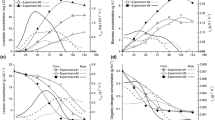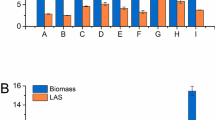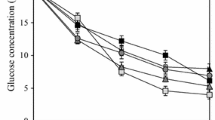Abstract
The effect of culture conditions such as medium composition and shear stress on the fungal pellet morphology in shake-flask cultures and its relation to glucose oxidase (GOD) excretion by recombinant Aspergillus niger NRRL 3 (GOD 3–18) was investigated. It was shown that culture conditions resulting in the formation of smaller fungal pellets with an increased mycelial density result in higher yields of exocellular GOD. The pellets obtained in shake-flask cultures showed distinct layers of mycelial density with only the thin outer layer consisting of a dense mycelial network. The performance of the recombinant strain and the process of pellet formation was also analyzed during batch cultivation in a stirred-tank bioreactor. It was shown that the process of pellet formation occurred in two steps: (1) aggregation of free spores to spore clusters with subsequent germination and formation of small aggregates surrounded by a loose hyphal network, and (2) aggregation of the primary aggregates to the final full-size pellets. The fungal pellets formed during bioreactor cultivation were smaller, did not show large differences in mycelial density, and were more efficient with respect to the production of exocellular GOD. The decreasing pellet size also correlated with an increased mycelial density, indicating an improvement of the transport of nutrients to the inner parts of the pellet.
Similar content being viewed by others
References
Kopetzki, E., Lehnert, K., and Buckel, P. (1994), Clin. Chem. 40, 688–704.
Ruttloff, H. (1994), in Industrielle Enzyme, 2nd ed., Ruttloff, H., ed., Behr’s Verlag, Hamburg, Germany, pp. 843–855.
Bucke, C. (1983), in Microbial Enzymes and Biotechnology, Fogarty, W. M., ed., Applied Science Publishers, London, pp. 93–129.
Foster, K. A., Frackman, S., and Jolly, J. F. (1995), in Biotechnology, 2nd ed., vol. 9, Rehm, H. J. and Reed, G., eds., VCH, Weinheim, Germany, pp. 73–120.
Hellmuth, K., Pluschkell, S., Jung, J.-K., Ruttkowski, E., and Rinas, U. (1995), Appl. Microbiol. Biotechnol. 43, 978–984.
Pluschkell, S., Hellmuth, K., and Rinas, U. (1996), Biotechnol. Bioeng. 51, 215–220.
Archer, D. B., MacKenzie, D. A., and Ridout, M. J. (1995), Appl. Microbiol. Biotechnol. 44, 157–160.
Wittler, R., Baumgartl, H., Lübbers, D. W., and Schügerl, K. (1986), Biotechnol. Bioeng. 28, 1024–1036.
Hotop, S., Möller, J., Niehoff, J., and Schügerl, K. (1993), Process Biochem. 28, 99–104.
Elmayergi, H., Scharer, J. M., and Moo-Young, M. (1973), Biotechnol. Bioeng. 15, 845–859.
Galbraith, J. C. and Smith, J. E. (1969), Trans. Br. Mycol. Soc. 52, 237–246.
Prosser, J. I. and Tough, A. J. (1991), Crit. Rev. Biotechnol. 10, 253–274.
Franke, W., Eichhorn, G., Möchel, L., and Bertram, I. (1963), Arch. Mikrobiol. 46, 96–116.
Author information
Authors and Affiliations
Corresponding author
Rights and permissions
About this article
Cite this article
El-Enshasy, H., Hellmuth, K. & Rinas, U. Fungal morphology in submerged cultures and its relation to glucose oxidase excretion by recombinant Aspergillus niger . Appl Biochem Biotechnol 81, 1–11 (1999). https://doi.org/10.1385/ABAB:81:1:1
Received:
Accepted:
Issue Date:
DOI: https://doi.org/10.1385/ABAB:81:1:1




